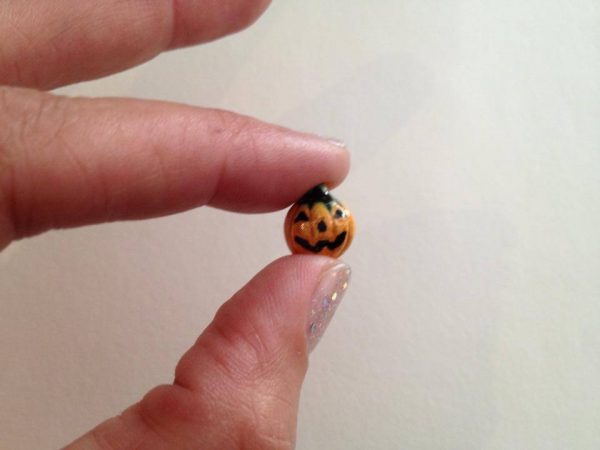Happy Halloween! Super-Leaded Tiny Pumpkin Bead (lots of Lead CAN come in very small packages!): 17,500 ppm Lead
Alternate Title:
#AskTamara: What types of beads are safe for my children to play with?
For those new to this website:
Tamara Rubin is a multiple-federal-award-winning independent advocate for childhood Lead poisoning prevention and consumer goods safety, and a documentary filmmaker. She is also a mother of Lead-poisoned children (two of her sons were acutely Lead-poisoned in 2005). Since 2009, Tamara has been using XRF technology (a scientific method used by the U.S. Consumer Product Safety Commission) to test consumer goods for toxicants (specifically heavy metals — including Lead, Cadmium, Mercury, Antimony, and Arsenic). Tamara’s work was featured in Consumer Reports Magazine in February 2023 (March 2023 print edition).
Happy Halloween!
This tiny ceramic pumpkin bead was positive for 17,500 ppm Lead (Pb) when tested with an XRF instrument. This is a good example showing that it is possible to test a very small item with an XRF instrument (I have heard over the years that some hazard assessors have said certain items are too small to be tested, and that’s simply not true in most cases).
To learn more about XRF testing, click here.
While the concern over whether or not a ceramic bead with Leaded glaze may or may not poison the user has not been well-studied, an object like this could definitely present a Lead-poisoning hazard if swallowed by a child.
The amount of Lead (Pb) considered toxic in an item intended for children is anything 90 ppm Lead and higher in the glaze or coating or anything 100 ppm or higher in the substrate. #ReallySpooky!
Most small ceramic beads like this (sold at Michael’s, Joanne’s, and elsewhere) are not going to be Lead-free and I would not consider them safe for use by children. When originally sold, they are most often specifically marketed as being craft supplies intended to be used by adults.
As an alternative (to make sure beads are Lead-free), consider beads made from natural materials (seeds, shells, nuts, stones). Kids can easily turn these sorts of beads into things like pumpkins themselves with a nice little paintbrush and some acrylic paint!
To see more beads I have tested, click here.
Here are some examples of natural beads that I found on Amazon*:
While there are other obvious environmental considerations with plastic, new plastic beads made and sold specifically intended to be used by children should also be Lead-free.
My sons prefer to make their own beads out of Fimo® brand clay or Sculpey® brand clay — and those products are definitely Lead-free! Here are some links to some good choices on Amazon:
It seems we almost always have a tray of Fimo® clay beads on the counter that are ready for baking. My kids really love the activity and they also have a lot of fun sitting out on the corner by our house selling their creations to passersby. I really love this because in making and selling beads and necklaces they learn about so many different subjects:
- art/sculpture
- colors/color-blending
- geometry (only certain shapes of beads work well on necklaces!)
- bead-making (some things are too small or delicate to turn into beads, it turns out, and other things are too large and cumbersome — so this is a very specific set of skills!)
- jewelry making (what works on a string, what sells, what people are interested in!)
- commerce (deciding how much to charge and figuring out what their profit margins will be)
- marketing (apparently, cute younger/smaller brothers help to sell more beads, for more money!)
- conversation skills (talking to strangers — which is actually a really good skill to have/customer relations!)
- and math (counting the money they earn from selling their beads! LOL!)
For #SaferChoices for your family,
check out my Amazon Store.*
As always, Thank You for reading and for sharing.
Please let me know if you ever have any questions!
Tamara Rubin
#LeadSafeMama
To make a contribution in support of our independent consumer goods testing and Lead poisoning prevention advocacy work, click here. Thank you!
*Amazon links may be affiliate links. If you purchase something after clicking on one of these links WE may receive a small percentage of what you spend at no extra cost to you. Thank you for supporting OUR advocacy work in this way!
Never Miss an Important Article Again!
Join our Email List










I believe Fimo has been tested to have a lot of toxic PFAS. Not a safe product.
Plasticine is apparently ok…no PFAS anyway.